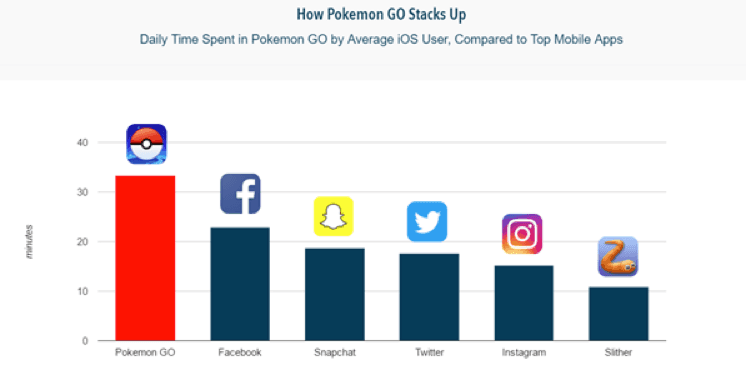If the frenetic enthusiasm aroused by Pokemon Go in its infancy has somewhat subsided, the game has nevertheless established itself as a benchmark in mobile video games and still generates considerable revenue: more than half a billion dollars in revenue since its launch in July 2016!
We are well aware that there are several definitions of uberization. For this article, we will limit ourselves to talking about uberization as the process by which radical innovation will destabilize a sector and its actors. By challenging the functioning of established players in the video game industry, Pokemon GO has uberized its industry.

In August 2016, more time was spent playing Pokémon GO than using other apps from the App Store
The Pokémon GO phenomenon proves once again that in recent years, startups are at the origin of the great innovations of capitalism. Niantic has revolutionized the mobile video game industry by introducing augmented reality into its products - first with Ingress in 2012 and then with Pokemon GO today.
But innovation also takes place in the business model. Of course Pokemon GO contains in-app purchases, but in the long term, a large part of the profits will come from advertising for local businesses. McDonald's has already entered into a partnership in Japan to have three hundred arenas located in their restaurants.
Finally, the major innovation brought by Pokemon Go to the world of mobile video games is its ability to mobilize all the functionalities of our smartphones to produce an exceptional gaming experience. We use geo-localization to move around, we catch our Pokémon with our camera, we relay our catches via social networks… In short, the main functions of our laptops are all used for the game!
And in the video game sector, everyone is overwhelmed: both classic publishers who have never succeeded in fully adapting to the mobile market (Electronics Arts, Activision, Ubisoft etc.) and publishers specializing in applications mobiles like King (editor of Candy Crush) or Gameloft (editor of the Asphalt series). To convince you, know that in August Pokemon Go garnered more revenue per day than all the other mobile applications combined!
Pokemon lean
Pokemon GO is also proof that the lean startup is currently the best way to launch a product. When it was released, the game contained countless bugs and the servers were unable to handle such a flow. But the user experience was so good that gamers were still looking to play it. Thanks to the feedback collected since the game's release, Niantic was able to quickly fix the main bugs and get new ideas to improve the game.
It should be noted that this strategy is deliberate and does not indicate poor preparation for the game's release. Before its generalization, Niantic tested its new radar in the city of San Francisco and has it. adjusted in small steps, until it is optimal and ready to be extended to the rest of the world. We test on a sample, we get feedback, we improve and we start again until we are satisfied with the final functionality.
The actors of this uberization
Niantic was born in 2010 as an internal subsidiary of Google. John Hanke has been at its helm since its inception. Previously, he was the instigator of Google Earth and for a few years led the Geo division of Google. Niantic was created with the goal of finding new products that make the most of the group's mapping services. The startup first launched Field Trip, a service that sends notifications to points of interest near us. Then, gradually, the startup centered its activity around mobile video games.

Mobile screenshots of Niantic's first app, Field Trip
In 2012, Niantic released the group's first video game. Ingress is an alternate reality game that pits two teams against each other to control portals represented on a collaborative map. These portals are created based on player proposals (who submit ideas for places with a photo and description).
It should be understood that Niantic used Ingress as the technological and economic glue to build Pokemon GO. Thus, arenas and Pokéstops are located in the same places as Ingress portals.
Initially, Ingress considered a different monetization of their product, rejecting in-app purchases that severely affect the user experience of gamers. Their idea was to establish advertising partnerships with major brands (AXA, Mitsubischi, Motorola and even Vodafone) so that they have their own customizable portal.
But in August 2015, when Google restructured around the Alphabet holding company, the startup was forced to take off and find new sources of income. Niantic was then forced to provide Ingress with a traditional in-app purchase system.
Three months after gaining its independence, Niantic raises $ 30 million from Nintendo, The Pokemon Company and Google (20 million granted directly and 10 million additional if the startup achieves certain objectives). In early 2016, Niantic receives an additional 5 million euros. These funds made it possible to develop and launch Pokémon GO.
The success of the Trinity: the brand (Pokemon), the big companies (Google and Nintendo) and the startup (Niantic)
These three players have uberized the video game industry by proceeding in an unprecedented way to create Pokemon GO. Both Nintendo and Google are investors, who make their many resources available to the startup: Niantic has enjoyed almost total freedom to develop its game.
For Nintendo and the Pokemon Company, this operation was a winning bet allowing them to take their first steps in the mobile world. Until then, only Nintendo had had the right to develop video games around Pokémon. Instead of running the risk of embarking on a very specific sector of video games, the Japanese firm preferred to line up a few million and entrust this mission to an expert. With Pokémon Go, Nintendo is reaching the billion people who play on mobile without having in-depth knowledge of it.
From its inception, Niantic was an independent business unit from the rest of Google. From then on, she had two exit strategies: either she would reintegrate her technology into the group, or she would leave it permanently.
Two major reasons explain why Niantic wanted to take off on its own:
The startup looked more like a video game publishing company than a box working around Google services,
Google is keen to maintain its neutrality in its activities, which are for the majority of platforms (Play Store, Google Maps) on which everyone can work without some being advantaged. To launch Pokemon GO, Niantic needed to ally with Nintendo, which defied Google's desire for neutrality.
But this rather particular separation goes against the current strategy of Google which jealously guards the projects supported and incubated. Alphabet aims to be a flexible structure capable of housing different companies and cultures so as not to lose potential sources of income.

The structure of Alphabet, the holding company of Google
In a nutshell
With Pokemon GO, Niantic has uberized the video game industry by bringing radical innovations in the user experience, in the business model or in the way of building the application.
Today, most of the big disruptive innovations are introduced by startups. The lean startup mode helps them structure their innovation process through the create-test-learn cycle.
If a large group wants to stay at the forefront of innovation, we see two effective solutions: investing in startups like Nintendo, hosting a “startup studio” like Google.

